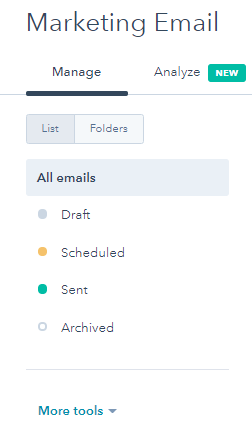How to Determine Your KPI for Marketing and Sales
KPIs, or key performance indicators, are crucial to measuring and implementing successful digital marketing strategies. Take less than two minutes to learn how to use KPIs from the experts:
Determining unique key performance indicators (KPIs) is essential for marketing and sales teams. Without specific metrics guiding you, there is no standard of measuring how your company grows.
Begin determining the best KPIs for your business by answering these six questions:
- What are your company-wide, time-bound business goals?
- Do departmental goals support overall goals?
- Which data source(s) is your source of truth?
- What actions are you currently tracking – and not tracking – that are important to your business?
- Should you be measuring progress in all parts of the marketing/sales funnel?
- Should your KPIs be specific to a geographic location?
You’re well on your way to more accurately measuring progress. Let’s dig in to some KPI examples.
5 Common Key Performance Indicators
These are extremely common marketing and sales KPI examples:
- Sales revenue
- Cost per lead
- Sessions or pageviews (by channel)
- Website conversions (by channel)
- Inbound marketing ROI (return on investment)
Of course, there are hundreds of valuable KPIs. Some are “leading KPIs,” which show trends implying future performance. Some are “lagging KPIs,” which measure performance already achieved. Both are valuable!
Below, we break down how to determine your KPI within specific digital marketing channels.
Channel-Specific Examples of How to Determine Your KPI
While it’s good to have some simple, overarching KPIs for sales and marketing, you may also want to get more granular. At Oneupweb, for example, we find it helpful to identify KPIs for the central goal, plus metrics to measure microgoals we’ll achieve along the way. This often involves breaking down data by channel.
The below channel-specific KPI examples are based on the default channel groupings in Google Analytics. (See definitions here.) If you use custom channel groupings or a different analytics platform, the process of how to determine your KPI might vary.
Content Marketing & SEO KPI Examples

Resource content such as blogs, whitepapers and downloadable documents are great ways to attract and engage new users, as well as your existing audience. If your business is heavily invested in content marketing and SEO, you should consider these KPIs:
- Conversions (sales form, call, etc.)
- Conversion rate
- Leads (newsletter signup, resource download, event registration, etc.)
- Organic search sessions
- Organic search engagement (bounce rate, time on page, pages per session, scroll depth, etc.)
- Inbound link clicks
- Backlinks – Learn our favorite link building strategies.
- Keyword metrics (# of keywords, featured snippets, average position, impressions, etc.)
- Return on SEO investment – See how we calculate SEO ROI.
- Social media referrals to resource content
Paid Advertising KPI Examples
Goals related to paid media typically measure audience awareness, consideration and conversion. Here are some of the best KPIs to track for paid advertising:
- Impressions and impression share
- Clicks and CTR (clickthrough rate)
- Conversions (sales form, call, etc.)
- Conversion rate
- ROAS (return on ad spend)
- CPA (cost per acquisition)
- Quality score – either internally calculated or generated by Google
Email Marketing KPI Examples

To determine how your email marketing strategy is performing, we recommend tracking these KPIs:
- Deliverability rate
- Opens and open rate
- Clickthrough rate
- Email referral sessions
- Unsubscribe rate
- Conversions
Social Media Marketing KPI Examples

Social media marketing KPIs may resemble your paid advertising KPIs, with the addition of engagement and reach metrics. Here are top social media marketing KPIs to track:
- Engagement – especially likes, comments, shares and mentions
- Followers
- Impressions
- Social media website sessions
- Leads
- Conversions
- Lead-to-conversion rate
- Cost per lead
- Revenue
SproutSocial has further social media KPIs organized in categories.
YouTube KPI Examples
As YouTube continues to increase in popularity, it’s becoming more important to optimize your YouTube channel and measure performance. These are common YouTube KPIs:
- Total watch time
- Average view percentage
- Likes and shares
- Views
- Subscribers
- YouTube-referred website sessions and conversions
Prioritizing These YouTube Metrics
Certain YouTube KPIs should be prioritized over others. Our agency recommends prioritizing total watch time and average view percentage (otherwise known as retention) first because these metrics provide a holistic view of your channel’s performance. Watch time also has direct impact on video rankings and monetization. Likes and shares, or video engagement metrics, are good indicators of how well a video is resonating with your audience.
Views and subscribers should be prioritized next, and analyzed in combination with retention and watch time. Think of views and subscribers more as vanity metrics – they don’t mean a lot on their own. And finally, YouTube-referred website sessions and conversions should be prioritized last. YouTube ranks channels that keep viewers on the YouTube domain higher than channels that lead viewers away. So, while sessions and conversions are good for your bottom line, they don’t necessarily help your YouTube channel’s performance.
For example, here’s part of a YouTube report (in Google Looker Studio) that Oneupweb produces for a fairly recent YouTube services client:

Conversion Rate Optimization KPI Examples
CRO (conversion rate optimization) is testing changes to your website to help increase the percentage of sessions that result in a conversion – however you define that. After you make CRO updates, these KPIs will help you understand how the changes impacted your website:
- Conversion rate
- Engagement metrics (bounce rate, time on page, pages per session, scroll depth, etc.)
- Internal link clicks or resource downloads
- Shopping cart abandonment rate
Sales Team KPIs
Sales teams may focus on different KPIs from their marketing team. This can work well if they support the same overarching goal. Here are some common sales-team KPIs:
- Sales (total and by channel)
- Lead-to-sale rate
- Lead quality
- Number of engagements per rep
- Customer lifetime value
- Retention and churn rates
Improve Digital Marketing Reporting & Progress
If you need help narrowing in on appropriate KPIs and setting up custom tracking, Oneupweb is here to help. We’ll provide easy-to-digest reports and anything else you need to knock it out of the park with your marketing strategy. Call us at (231)-922-9977, or contact us online to get started today.
